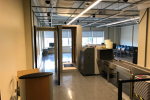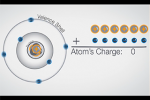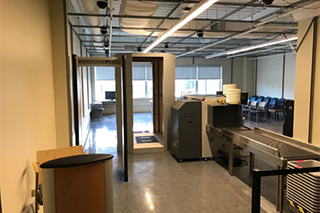News & Events
Video
ALERT Launches Video Analytics Lab at Kostas Research Institute May 30, 2017

A Better Testing Facility for Solving Real World Problems
Northeastern University’s George J. Kostas Research Institute for Homeland Security is now home to ALERT’s new Video Analytics Laboratory. Providing secure access, 1225 sq. feet of open space, controlled lighting conditions, and a fully networked and flexible camera grid, ALERT can better investigate and develop video and sensor technologies to address the needs of the Homeland Security Enterprise.
Using Video Technologies to Improve Passenger Experience
The first research project to leverage the lab is entitled Research and Development of Systems for Tracking Passengers and Divested Items at the Checkpoint. Supported by the DHS Science and Technology Directorate through the DHS Office of University Programs, this project is known by the acronym CLASP (Correlating Luggage and Specific Passengers) and leverages the technical expertise of ALERT research teams from Boston University, Marquette University, Northeastern University, Purdue University, and Rensselaer Polytechnic Institute. These teams will work towards developing an automated system capable of tracking passengers and divested items at airport security checkpoints.
CLASP will primarily focus on using video technologies to assist the Transportation Security Administration (TSA) in effectively identifying security incidents like theft of items, or bags left behind at the checkpoint. By automating and improving the technologies associated with these objectives, ALERT hopes to improve rates of detection and at the same time improve the passenger experience.
CLASP was the result of DHS’s interest in initial work done by ALERT Project Investigator Richard Radke’s lab. A video of their work can be seen below:
(Z. Wu and R.J. Radke, Real-Time Airport Security Checkpoint Surveillance Using a Camera Network. Workshop on Camera Networks and Wide Area Scene Analysis, in conjunction with CVPR 2011, June 2011.).
Government & Industry Partners Make the Difference
In order to deliver the system outlined in CLASP, the researchers working on the project require access to video data displaying real-world checkpoint security situations. Actual airport security video is generally restricted, so ALERT partnered with Massport, the Transportation Security Administration at Boston Logan International Airport, and industrial partners such as Rapiscan Systems to create an accurate representation of an airport security checkpoint in the ALERT Video Analytics Laboratory. This full-scale, mock airport security checkpoint uses the same hardware and design specifications currently used by the TSA at airports such as Logan, and gives ALERT a space to generate usable video data for this project and hopefully to the video analytics research community as a whole.
CLASP is just the beginning of work that can be done in this new laboratory and ALERT is hoping to leverage it for additional homeland security-related projects going forward. If you are interested in partnering with ALERT on future projects, please connect with us via email at [email protected].
Check Out Our Latest ALERT 101 Video March 31, 2017

ALERT 101: The Basics – Atoms and Molecules
The prequel to ALERT 101 – Methods of Chemical Characterization and Mitigation, ALERT 101 – The Basics: Atoms and Molecules, provides an introduction to atoms and molecules. This video describes the structure of atoms, basic behaviors and properties of atoms, and how atoms bond to form molecules. Different methods of molecule identification are also discussed.
For users without YouTube access: ALERT 101 – The Basics: Atoms and Molecules
Inspired by the success of TED (www.ted.com) and other educational media forums, ALERT has developed the ALERT 101 video series. Each video short features different technologies and research areas that the ALERT Center engages in. We hope that these productions help educate and inform the global community on these topics in an accessible and enjoyable way
This material is based upon work supported by the U.S. Department of Homeland Security, Science and Technology Directorate, Office of University Programs, under Grant Award 2013-ST-061-ED0001. The views and conclusions contained in this video are those of the authors and should not be interpreted as necessarily representing the official policies, either expressed or implied, of the U.S. Department of Homeland Security.
Northeastern News spotlights ALERT research in Airport Security Technologies April 28, 2016

FUTURE OF AIRPORT SECURITY – Northeastern News, 4/28/2016
According to the International Air Transport Association, about 8 million travelers make their way through airports around the world each day. Traditional security requires passengers to stand still while being screened, but Northeastern researchers are developing cutting-edge technology that can detect suspicious behavior—even when passengers are on the move…
Profs. Camps, Martinez, Radke, Rappaport, and Sznaier’s work is featured in this dynamic video story.
Read MoreWatch the Latest ALERT 101 January 30, 2015

ALERT is proud to present the third installment of ALERT 101. This chapter’s topic focuses on Methods of Chemical Characterization and Mitigation, and is part 1 of a 2 part series. ALERT Thrust Leaders Jimmie Oxley (Thrust 1) and Steve Beaudoin (Thrust 2) provide commentary about the crucial role of chemical characterization in the mitigation of explosives-related threats, and how ALERT research is helping first responders and security personnel to detect and eliminate threats before they can be used for malicious reasons.
Chemical characterization for the purpose of explosives detection requires ALERT researchers to classify what are explosive materials, and what are not. In the lab, researchers observe how chemicals uniquely react to stimuli, thus determining their chemical properties. For example, Differential Scanning Calorimetry subjects the chemical samples to heat, thus producing a specific reaction that can then be compared to the Explosives Database managed by the University of Rhode Island to determine if the chemical is a volatile substance.
Researchers then leverage these chemical characterizations to develop sensors that detect explosive threats. Trace analysis techniques are used to sense when chemical residues are present on surfaces of or in the air around materials by picking up small quantities of the chemicals when they are in the solid or vapor phases. One such trace method uses a polymer swab developed by Prof. Beaudoin, to sense chemicals in the solid phase on an object’s surface. This swab has individual fingers, similar in design to a toothbrush, with chemical head groups attached to the ends that attract and hold the residue to the finger. ALERT continues to advance the state-of-the-art in both solid and vapor trace technologies through their recently established Trace Explosives Sampling for Security Applications (TESSA) workshops.
As a supplement to this installment, stay tuned for ALERT 101: Basic Properties of Atoms and Molecules, coming this spring!
Inspired by the success of TED (www.ted.com) and other educational media forums, ALERT has developed the ALERT 101 video series. Each video short features different technologies and research areas that the ALERT Center engages in. We hope that these productions help educate and inform the global community on these topics in an accessible and enjoyable way.
New England Cable News (NECN) Interviews ALERT Researcher, Prof. Carey Rappaport, on Breast Imaging Research October 26, 2014

Prof. Carey Rappaport, ALERT researcher in the College of Engineering at Northeastern University, was recently interviewed by the New England Cable News about his team’s microwave breast imaging research for safer breast cancer screenings. Watch the interview below:
ALERT 101 is Back! July 17, 2013

ALERT 101: Video Analytics
We are pleased to present the second installment of ALERT 101. This segment’s topic is Video Analytics. ALERT researchers Richard Radke, Octavia Camps, and Venkatesh Saligrama explain what it is, how it’s used, and how they teach computers how to see and learn.
For users without YouTube access: ALERT 101: Video Analytics
This material is based upon work supported by the U.S. Department of Homeland Security under Award(s) 2008-ST-061-ED0001 and/or 2008-ST-061-ED0002. The views and conclusions contained in this document are those of the authors and should not be interpreted as necessarily representing the official policies, either expressed or implied of the U.S. Department of Homeland Security
Inspired by the success of TED (www.ted.com) and other educational media forums, ALERT has developed the ALERT 101 video series. Each video short features different technologies and research areas that the ALERT Center engages in. We hope that these productions help educate and inform the global community on these topics in an accessible and enjoyable way.
David Castanon discusses ALERT-related research December 6, 2012
Watch Professor Castanon talk about his work in luggage screening, video analytics and explosives detection with the National Science Foundation:
ALERT presents the first installment of ALERT 101: Airport Screening Technologies December 1, 2012

We invite you to watch the first episode of ALERT 101 which focuses on the applications of Millimeter Wave Scanning and Backscatter X-ray in Airport Security Screening.
For users without YouTube access: ALERT 101: Airport Screening Tecnologies
Inspired by the success of TED (www.ted.com) and other educational media forums, ALERT has developed the ALERT 101 video series. Each video short will feature different technologies and research areas that the ALERT Center engages in. We hope that these productions help educate and inform the global community on these topics in an accessible and enjoyable way.
ALERT Researcher Carey Rappaport discusses his work with Northeastern University November 28, 2012
Watch Professor Rappaport talk about his Homeland Security Related Research with Northeastern University:
An Introduction to the Research and Industrial Collaboration Conference (RICC) October 3, 2012
For more than a decade, the RICC has fostered in-depth dialog among members of the academic, industrial and government communities interested in collaboration in subsurface sensing and imaging and homeland security related topics. This video, taken at the 2011 RICC, provides an overview of the successful event from the perspective of its participants.

